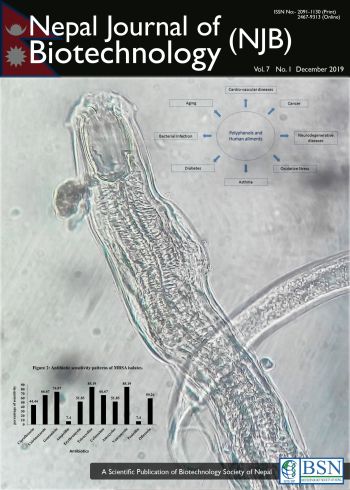Antimicrobial Resistance Patterns and Plasmid Profiles of Methicillin Resistant Staphylococcus aureus Isolated from Clinical Samples
DOI:
https://doi.org/10.3126/njb.v7i1.26945Keywords:
Staphylococcus aureus, antibiotic resistance, methicillin resistance S. Aureus, plasmidAbstract
Methicillin-resistant Staphylococcus aureus (MRSA), showing resistance to several antibiotics is a global health problem associated with considerable mortality and morbidity. Antibiotic susceptibility test is a commonly used method to characterize MRSA in epidemiologic studies. Additionally, plasmid profile has been reported to be useful in tracing the epidemiology of antibiotic resistance. This research was conducted to determine the antimicrobial resistance patterns and plasmid profiles of MRSA isolated from clinical samples at KIST Medical College, Imadol, Kathmandu, Nepal. All the clinical specimens sent to the laboratory were processed by standard microbiological techniques and antibiotic susceptibility testing was done by the modified Kirby Bauer disc diffusion method. Further, plasmid profiling was done by Alkaline-lysis method. A total of 27 (38.02%) MRSA were isolated from 71 S. aureus positive samples. MRSA showed the highest resistance towards penicillin (92.60%) and ampicillin (92.60%). In contrast, high levels of sensitivity were shown towards vancomycin (85.19%) and tetracycline (85.19%). Out of 27 MRSA positive samples, single plasmids were isolated from only 6 (22.22%) MRSA isolates. Antibiograms alone are inadequate to accomplish the characterization of MRSA during epidemiological studies. However, plasmid profile analysis in conjunction with the antibiotic susceptibility pattern is valuable in the epidemiological investigation of MRSA, and for reducing MRSA prevalence and treatment cost.
Downloads
Downloads
Published
How to Cite
Issue
Section
License
Copyright Notice:
The manuscript submitted to NJB must be an original contribution, not previously published and should not be under consideration for publication elsewhere. When the manuscript is accepted for publication, the authors agree to automatically transfer the copyright of the article to the publisher. It should grant permission to any third party, in advance and in perpetuity, the right to use, reproduce or disseminate your article, according to the NJB copyright and license agreement.
Authors transfer copyright to the publisher as part of a journal publishing agreement but have the rights to: Share their article for Personal Use, Internal Institutional Use and Scholarly Sharing purposes, with the NJB applies the Creative Commons Attribution-NonCommercial CC BY-NC license to all the works we publish after Jun 2020 (Before it was CC BY-NC-ND). Under this license, authors agree to make articles legally available for reuse, without permission or fees, for virtually any non-commercial purpose. Anyone may remix, adapt, and build upon your work non-commercially, and although their new works must also acknowledge you and be non-commercial, they don’t have to license their derivative works on the same terms. More details on CC BY-NC refer to its Licence Deed and Legal Code.






